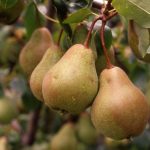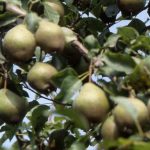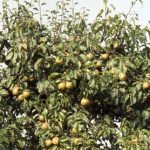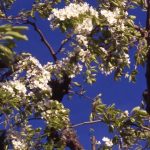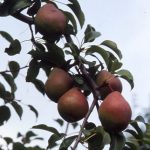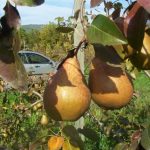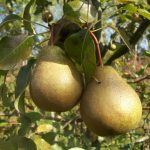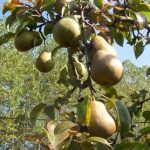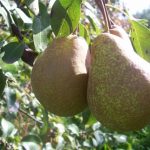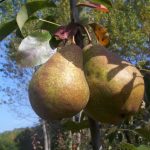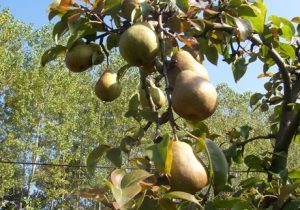
Name
Madernassa Pear
Seal of quality
Prodotto Agroalimentare Tradizionale (PAT) – Typical Food Farming Product. Procedures for IGP (Indication of protected origin) status are in course.
Description
This is a vigorous, rustic and extremely fertile tree, subject to productive alternation in old implantations or in those grafted in plants obtained from the seed and not from vegetative reproduction. Flowering is medium – early – season. It is a parthenocarpic variety (it also yields seedless fruits).
The fruit is medium- small-sized, piriform, quite regular, slightly flattened at the two extremities, with thin medium – long stalk, inserted in a small cavity, quite rough, rusty-coloured skin, a sallow green, lightly covered with a pale red, with numerous irregular lenticels, small core, light-yellowish white pulp, crispy and slightly granular, a light fragrance, with a sweet, slightly tannic flavour.
One pear weighs on average 150 g. The fruit has a good or fairly good preservability.
The Madernassa is a cooking pear, i.e. its best characteristics enhanced by cooking, although it can be eaten raw, when ripe.
Nutritional characteristics
These pears have a low calorie-content (30 – 35 kcal per 100 g), they are rich in insoluble fibre, and contain a fair quantity of potassium. They have quite a high index of saziety and, therefore, suitable for snacks or to be eaten at the end of a small meal.
| FOOD | pere fresche senza buccia | |
|---|---|---|
| Edible part | % | 84 |
| Water | g | 87,4 |
| Protein | g | 0,3 |
| Fat | g | 0,1 |
| Carbohydrates | g | 8,8 |
| Starch | g | 0 |
| Soluble sugar | g | 8,8 |
| Total fibre | g | 3,8 |
| Energy | kcal | 35 |
| Kilojoules | kJ | 147 |
| Sodium | mg | 2 |
| Potassium | mg | 127 |
| Iron | mg | 0,3 |
| Calcium | mg | 11 |
| Phosphor | mg | 15 |
| Thiamine | mg | 0,01 |
| Riboflavin | mg | 0,03 |
| Niacin | mg | 0,1 |
| Vit A ret. eq. | mcg | tr |
| Vit C | mg | 4 |
| Vit E | mg |
Area of production
Once grown in many areas of Cuneo, today the area of production is limited to the more suitable areas of Roero and Valle Grana.
History
There are a few excerpts relative to an article written by prof. Raffaele Carlone in the periodical L’Italia Agricola: “The Madernassa was first described by Cavazza (1908) who glorified its rustic characteristics, productivity and long life […] it was later mentioned in the Pomon “Pomologia” (1916), emphasising the diffusion of the variety not only in Piedmont , but also out of the region. Only in 1927 was the variety brought to the attention fruit-growers at the “Congresso di Frutticoltura di Lugo”, during which its adoption was recommended also in other areas of northern Italy. […] The mother plant came from a seed that had fallen by chance on a plot of the Gavello farmhouse in Borgata Madernassa, on a hill situated between Guarene and Castagnito. When it started to yield its first fruits, the farmowner appreciated its goodness at once and, when the tree became rustic and vigorous, he spread it by grafting it over some pear trees that were already on the farm. Very soon, its cultivating and trading qualities became known to the neighbouring farmers, who multiplied them on their holdings and, from there, the cultivar spread throughout the Alba area. At first, the variety was given the name Gavello, to be given the name Madernassa only some time later: a relative approximation of its date of birth can be established, if we consider that the mother tree was cut down in 1914 and was about 130 years old. […] A popular opinion is that it was a cross between the Martin Sec cultivar and the wild one.”
Procedures for IGP recognition began in 1999 and are still in course.
